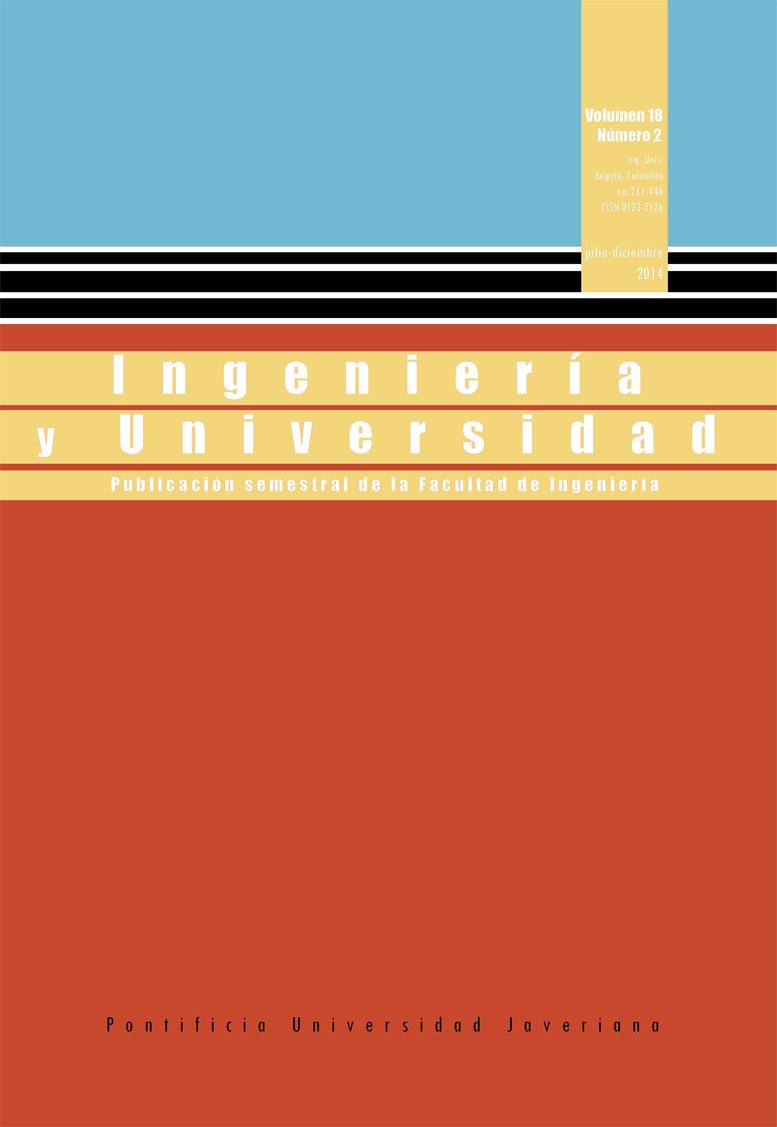Influence of the flow control (declining rate – constant rate) on the filtration process in drinking water treatment
##plugins.themes.bootstrap3.article.details##
Purification, since it is the final physical barrier to retain particles and control the microbiological risk. This study evaluated the influence of flow control on the filtration process of the clarified water of the Cauca River on the city of Cali –Colombia (Puerto Mallarino Water Treatment Plant) at pilot scale. Operation´s results of the pilot plant on a declining rate condition were compared with the results of the previous operation at constant rate; the operational control variables of the filters were turbidity of the filtered water and load loss. In general, the declining rate operation allowed a better performance of filters, resulting in a lower turbidity in filtered water during the period of máximum efficiency and a better outcome of the load loss, behavior that is associated with a better distribution of solids on the filter media, which allows to reduce the risk of transfer of particles through the filter.
Career of filtration, filtration, load loss, constant rate, declining rateCarrera de filtración, filtración, pérdida de carga, tasa constante, tasa declinante
ARBOLEDA, V. Teoría y práctica de la purificación del agua. 3a ed., tomo 2. Bogotá: McGraw-Hill, 2000.
AMERICAN WATER WORKS ASSOCIATION (AWWA). Water quality y treatment: a handbook on drinking water. 6th ed. New York: McGraw Hill Professional, 2011.
BOLLER, M. and KAVANAUGH, M. Particle characterics and head loss increase in granular media filtration. Water Research. 1995, vol. 29, no. 4, pp. 1139-1149.
CLEASBY, J. Declining rate filtration. Water Science & Technology. 1993a, vol. 27, no. 7-8, pp. 11-18.
CLEASBY, J. Status of declining rate filtration design. Water Science & Technology. 1993b, vol. 27, no. 10, pp. 151-164.
COLTON, J.; HILLS, P., and FITZPATRICK, C. Research note: Filter backwash and start-up strategies for enhanced particuale removal. Water Research. 1996, vol. 30, no. 10, pp. 2502-2507.
CORNWELL, D.; MACPHEE, M.; BROWN, R., and VIA, S. Demonstrating Cryptosporidium removal using spore monitoring at lime-softening plants. Journal of American Water Works Association. 2003, pp. 124-133.
CRITTENDEN, J., TRUSSELL, R., HAND, D., HOWE, K. Y TCHOBANOGLOUS, G. MWH’s Water Treatment: Principles and Design. John Wiley & Sons, 2012.
CRUZ, C. Filtração direta ascendente com alta taxa. Dissertação para Obtenção do título de Mestre em Hidráulica e Saneamento, Escola de Engenharia de São Carlos, Universidade de São Paulo, Brasil, 1993.
DABROWSKI, W. The progression of flow rates in variable declining rate filter systems. Acta Hydrochimica et Hydrobiológica. 2006, no. 34, pp. 442-452.
DI BERNARDO, L. Características hidráulicas dos métodos de operação dos filtros rápidos de gravidade. Revista DAE. 1983, no. 135, pp. 30-36.
DI BERNARDO, L. and SABOGAL PAZ, L.P. Seleção de tecnologias de tratamento de água. São Paulo: LDiBe, 2009.
ESCOBAR, J. Influência da capacidade de armazenamento de água a montante dos filtros no funcionamento de sistemas de filtração com taxa declinante. Dissertação para Obtenção do titulo de Mestre em Hidráulica e Saneamento, Escola de Engenharia de São Carlos, Universidade de São Paulo, Brasil, 1992.
FOURNIER, B. Gestión del riesgo sanitario en la regeneración del agua. Tesina de Especialización, Universidad Politécnica de Cataluña, Barcelona, 2006.
GAO, P. ; XUE, G. ; SONG, X.-S., and LIU, Z.-H. Depth filtration using novel fiber-ball filter media for the treatment of high-turbidity surface water. Journal Separation and Purification Technology. 2012, no. 95, 32-38.
JEGATHEESAN, V. and VIGNESWARAN, S. Deep bed filtration: mathematical models an observations. Environmental Science and Technology. 2005, vol. 35, no. 3, pp. 515-569.
KAWAMURA, S. Integrated design of water treatment facilities. 2nd ed. New York: John Wiley & Sons.
MACKIE, R.; ZIELINA, M., and DABROWSKI, W. Filtrate quality from different filter operations. Acta Hydrochimica et Hydrobiologica. 2003, no. 31, pp. 25-35.
MINISTERIO DE LA PROTECCIÓN SOCIAL-MINISTERIO DE AMBIENTE, VIVIENDA Y DESARROLLO TERRITORIAL (MPS-MAVDT). Resolución 2115, por medio de la cual se señalan características, instrumentos básicos y frecuencias del sistema de control y vigilancia para la calidad del agua para consumo humano. 2007.
MONTOYA, C.; LOAIZA, D.; TORRES, P.; CRUZ, C., and ESCOBAR, J. Efecto del incremento en la turbiedad del agua cruda sobre la eficiencia de procesos convencionales de potabilización. Revista EIA. 2011, no. 16, pp. 1794-1237.
MORENO, J. Avaliação e gestão de riscos no controle da qualidade da água em redes de distribuição: estudo de caso. Tese de doutorado, Escola de Engenharia de São Carlos Universidade de São Paulo, Brasil, 2009.
OKUN, D. Drinking water and public health protection. In: Pontius, F.W. Drinking wáter regulation and health. New York: John Wiley & Sons, 2003, pp. 13-14.
PEREA-TORRES, L.; TORRES-LOZADA, P.; CRUZ-VÉLEZ, C., and ESCOBAR-RIVERA, J. Influencia de la configuración del medio filtrante sobre el proceso de filtración del agua clarificada del río Cauca. Revista de Ingeniería. 2013, no. 38, pp. 38-44.
PÉREZ, A.; AMEZQUITA, C., and TORRES, P. Identificación y priorización de peligros como herramientas de la gestión del riesgo en sistemas de distribución de agua potable. Revista Ingeniería y Universidad. Bogotá. 2012, vol. 16, no. 2, pp. 449-469.
PLUMMER, R.; VELANISKIS, J.; GROSBOIS, D.; KREUTZWISER, R., and DE LOE, R. The development of new environmental policies and processes in response to a crisis: the case of the multiple barrier approach for safe drinking water. Environmental Science & Policy. 2010, vol. 13, no. 6, pp. 535-548.
RENNER, R.C. and HEGG, B.A. Self-assessment guide for surface water treatment plant optimization. n.l.: American Water Works Association (AWWA), 1997.
SPELLMAN, F. Handbook of water and wastewater treatment plant operations. 2nd. ed. Boca Raton: Taylor & Francis, 2009.
UNITED STATES ENVIRONMENTAL PROTECTION AGENCY (USEPA). Long term 1: enhanced surface water treatment rule turbidity provisions, technical guidance manual [document on line]. 2004.
UNITED STATES ENVIRONMENTAL PROTECTION AGENCY (USEPA). National primary drinking water regulations: long term 2 enhanced surface water treatment rule – Part II. n. l.: USEPA, 2006.
ZIELINA, M. and DAJBROWSKI, W. Impact of raw water quality on operation of variable declining rate filter plants. Environment Protection Engineering. 2011, no. 37, pp. 133-140.


